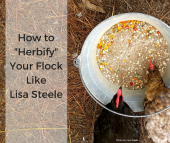
 4
4





 1
1




 My excuse is that my hands are too big, but actually she'd rather do this part than the plucking or skinning, so it works out. In any event, she uses a poultry scissors to open the cavity and remove the innards, cooking the liver and other parts either for herself or the dogs. Do just a few birds at a time, and before you know it, your chest freezer is pretty full.
My excuse is that my hands are too big, but actually she'd rather do this part than the plucking or skinning, so it works out. In any event, she uses a poultry scissors to open the cavity and remove the innards, cooking the liver and other parts either for herself or the dogs. Do just a few birds at a time, and before you know it, your chest freezer is pretty full.“The most important decision we make is whether we believe we live in a friendly or hostile universe.”― Albert Einstein
 1
1








My blog: http://simplicityforjulia.com/
 2
2




Julia Franke wrote:I recently processed my first batch of birds that were raised to be specifically meat.
I also butchered 3 laying hens that turned out be roosters.
I found it pretty empowering. To see our project from beginning to end and to also know that our chickens were raised happily and had one bad day. I feel like we are further along on our journey into the homesteading world.
One question: I have heard that you need to let the birds sit for 3 days after processing before eating. But in the second part of the "respectful chicken harvest" video, she says that she may be eating that chicken for dinner. How long do I have to wait from the time I harvest the chicken to the time I can cook it up?
Come join me at www.peacockorchard.com




YouTube channel: Midwest Homestead Solutions
MidwestHomesteadSolutions.com





|
Can you shoot lasers out of your eyes? Don't look at this tiny ad:
Freaky Cheap Heat - 2 hour movie - HD streaming
https://permies.com/wiki/238453/Freaky-Cheap-Heat-hour-movie
|









